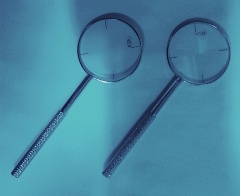Cross-Cylinder Technique for Subjective Refraction
All content on Eyewiki is protected by copyright law and the Terms of Service. This content may not be reproduced, copied, or put into any artificial intelligence program, including large language and generative AI models, without permission from the Academy.
Cross cylinder examination (otherwise known as Jackson's cross cylinder, JCC) is an examination used to refine the astigmatic refraction by fine-tuning the axis and strength of astigmatism. While a rough estimate can be obtained via retinoscopy or automated refractometry, cross-cylinder examination remains invaluable in fine-tuning the refraction for best vision.
Introduction
In 1887, Edward Jackson described a method of detecting astigmatism using modified Stokes’ lenses. He further modified this in 1907 to detect the axis of astigmatism by using a cross cylinder.[1] This cross-cylinder lens with a handle is called Jackson's cross-cylinder (JCC) (see image). The cross-cylinder technique derives its name from the fact that each of those cylinders can be considered as the combination of two equal yet opposite astigmatic lenses, placed perpendicularly between them. The sphere in the lens is double and of opposite power to the cylinder.
The two most commonly used in everyday practice are the following :
+0.25/ -0.50 (or -0.25/ +0.50)
+0.50/ -1.0 (or -0.50/ +1.0)
As the spherical equivalent of the lens is zero, placing it in front of the patient's eye doesn’t change the position of the conoid of Sturm, it can however reduce or increase the astigmatic error. Here, we describe the technique of determining astigmatism power and axis using a JCC lens.[2] However, the same principle applies when refracting a patient in the phoropter. The cross-cylinder technique starts by detecting the astigmatic axis first, then correcting the power of the astigmatism.
Detecting astigmatism
The standard examination of visual acuity starts by placing the patient in front of a Snellen’s chart. Best corrected vision with only spherical lenses is first determined. The patient is asked to see a line that 2-3 lines larger than the smallest line she can comfortably see. Then, a JCC lens of adequate power is placed, first with axis along 180 degrees and then at 90 degrees. If no difference is seen between the two axes, then the axis is changed to 45 degrees and 135 degrees and the test is repeated. If no difference is detected, then patient likely has minimal astigmatism and one should proceed with refining the spherical lens. If there is a difference in vision, then the axis is fine-tuned, as below. The JCC lens power chosen (0.5D vs 1D in a typical practice) depends on vision of the patient - it is important to use a cross cylinder with power large enough for the patient to appreciate a difference in vision at various axes. A patient with poor vision will need a larger power to appreciate a difference than a patient with good vision.
Correcting the astigmatic axis
The examiner holds the JCC instrument, with its handle aligning with the projection of the astigmatic axis, thus the positive and negative cylinder axes are straddling the astigmatic axis. By turning the instrument, the patient is asked to choose an axis that is closer to the positive or negative cylindrical axis of the JCC instrument. If the patient prefers the positive axis (for + cylinder lenses), we turn the axis 5-10 degrees towards it and the opposite if the patient prefers the negative axis instead. This process is repeated until the patient doesn’t notice any difference. This is the correct axis.
Correcting the power of astigmatism
With the axis in place, the accurate power of the cylinder can be determined. The positive axis of the JCC lens (for + cylinder lens) is turned parallel to the astigmatic axis. By repeating the same process as previously, the astigmatic lens power can be increased or decreased until the patient perceives no difference. Once the power of astigmatism is ascertained, the sphere is adjusted to obtain best correction.


